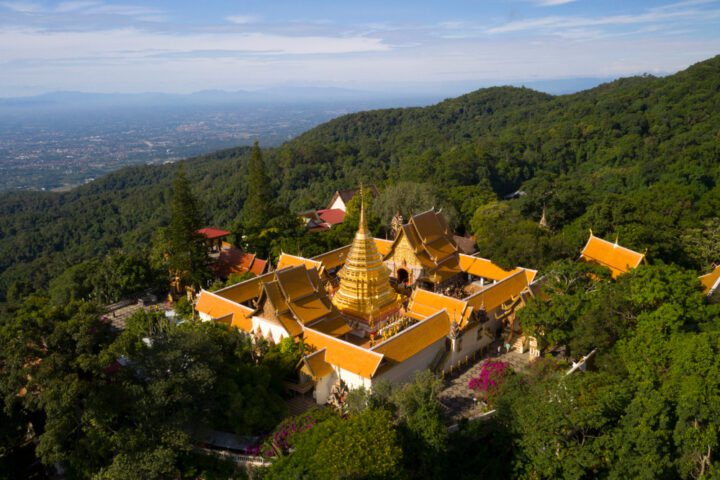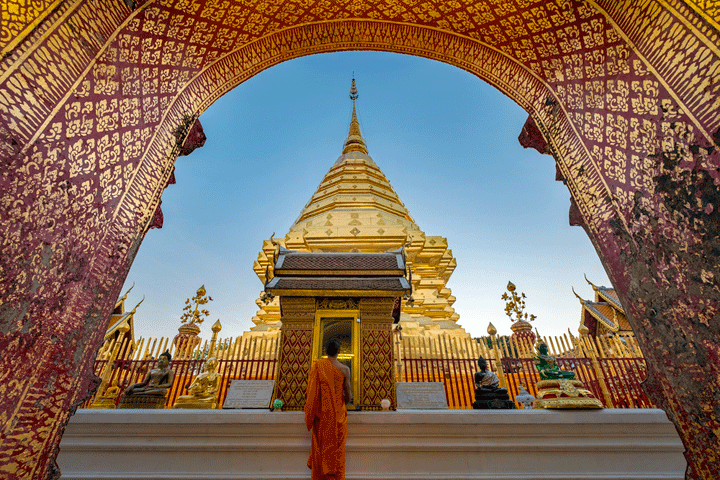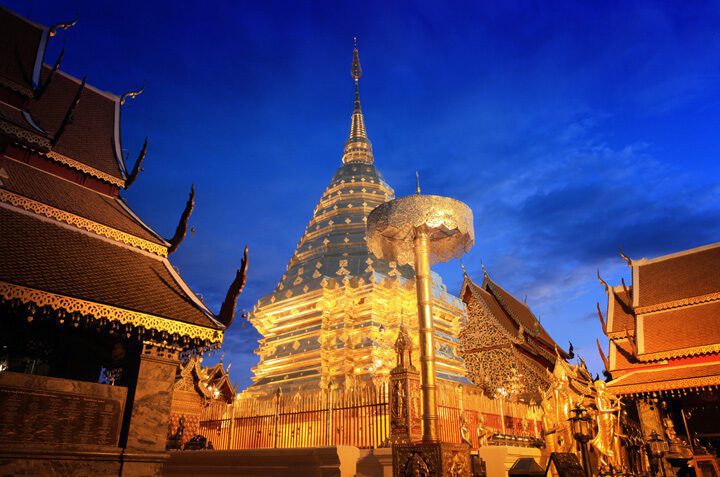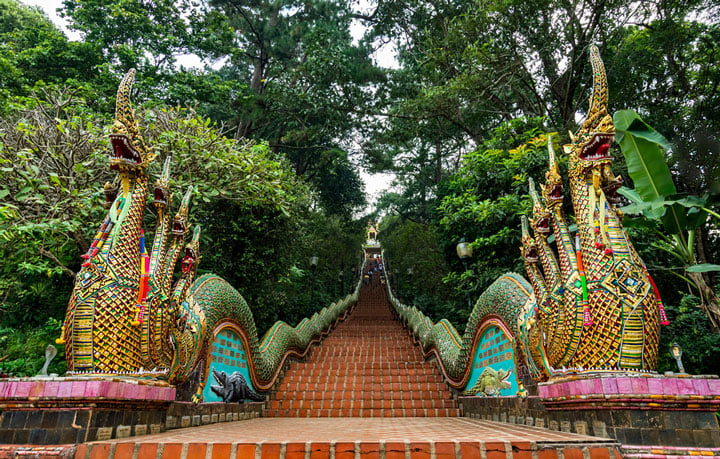Wat Phrathat Doi Suthep – crown jewel of Chiang Mai

Aerial view of Wat Phra That Doi Suthep temple in Chiangmai
Whenever I visit Chiang Mai, the Rose of the North, my gaze is drawn to the golden sparkle on the mountainside. When the sun glows the great gold-hued chedi of Wat Phrathat Doi Soi Suthep, I know I'm back—albeit momentarily—in what I've come to think of as a bit of "my" city over the years.
It actually makes me a bit melancholic and poetic and that, as far as I'm concerned, is only logical. Not only because it has been a long time since I last had the opportunity to stroll through the streets of Chiang Mai, but also because the radiance of this temple, which seems to be stuck on the flank of the Doi Suthep, always reminds the poet wakes me up and makes me resort to superlatives to describe him.
Wat Phrathat Doi Suthep, which is about fifteen kilometers from the city as the crow flies, is one of the most visited and revered temple complexes in northern Thailand. And that has been the case for a very long time. After all, this site was already the object of worship before the arrival of Buddhism, because the Lue, the original inhabitants of the region, firmly believed that the souls of their ancestors resided on the mountain. The temple is usually called Doi Suthep, but that is in fact not entirely correct because this is the name of the 1.676 meter high mountain on which it was built. The temple as we know it today probably dates back to the thirteenth century and is located at an altitude of 1.073 meters. The Doi Suthep, together with its counterpart Doi Pui, forms the core area of the Soi Suthep-Doi Pui National Park, one of the oldest protected nature reserves in Thailand that covers an area of approximately 265 km².

According to legend, the construction of this temple had everything to do with a dream that the pious monk Sumanathera had received, in which he had received instructions to go to Pang Cha to look for a relic of the Buddha. The monk, of course, immediately set out and found this relic, a scapula with magical powers assigned to it. He brought it to Sukhothai, but the reigning monarch there had the greatest doubts about the authenticity of the bones. Who did believe in it was the king of the northern principality of Lanna and he invited Sumanathera to Lamphun in 1368 with his bone.
For some unknown reason, the bone broke in two there, after which one part was buried in a temple in Suandok. The other part, for equally obscure reasons, was tied to the back of a white elephant, which was driven through Chiang Mai's northern Chang Puak Gate, or Gate of the White Elephant, and then chased into the jungle. This forest giant apparently did not climb the Doi Suthep without some effort, because once it reached the top, it trumpeted three times and then fell stone dead. That had to be a divine sign and so a temple was built on this place that would become Wat Phrathat Doi Suthep. The name Phrathat refers directly to the conscious Buddha relic. Thus the name of the temple, roughly translated something like the 'Temple on Doi Suthep where a Buddha relic is kept', is.

Visitors to the temple can, once they have braved the feverish beginning around the colorful sales stalls, climb the 309-step naga staircase - the longest in Thailand - or the slightly less sporty among us can join the 30 Baht for a deposit of 24 Baht. gondola of the creaking and groaning funicular. Once at the top we immediately find a statue of the white elephant, which was the basis for the foundation of this monastery and temple complex, but the main attraction is without doubt the always busy courtyard with the impressive, XNUMX meter high and richly decorated with gold leaf chedi . This chedi was built on an octagonal base, in accordance with the tradition in the north, and is surrounded by smaller stupas, altars, Buddha statues in every imaginable version and colorful wall paintings, not to mention the large suspended bronze bells.
You can find both Buddhist and Hindu shrines there. For example, there is a revered copy of the Emerald Buddha that is located in the Wat Phra Kaew in Bangkok, but also a striking Ganesha. Also noteworthy is the chatra, the large, gold-colored umbrella next to the large central chedi. This symbol is found in Hinduism, Buddhism and Jainism and is in fact not really Siamese, but a silent witness to two centuries of Burmese occupation (1558 to 1775) of Chiang Mai.

The 309-step naga staircase – the longest in Thailand
You can't miss it: Wat Phrathat Doi Suthep is a major tourist attraction, but despite the associated hectic pace and crowds, there can still be something soothing about a visit to this site. Why not come down at the crack of dawn to enjoy a sunrise over the city at your feet at the viewpoint? Or in the evening when the lights come on one by one in Chiang Mai and offer a magical spectacle? The only downside to a morning or evening visit is that the courtyard is closed.
The easiest way to get to Wat Phrathat Doi Suthep is the songthaew, the typical burgundy red baking taxis. But for a small price you can also take a taxi or van. I do not recommend scooters or mopeds because the road is not only quite winding, but when it rains it is often dangerously slippery, which in combination with the sometimes very busy traffic and the sometimes bizarre driving behavior of other road users does not really guarantee a safe arrival. And then of course there is also the so-called Monk Trail, a walking path that leads you to the monastery, but I will go into more detail about that in a next post about what else there is to see on the Doi Suthep…


Wonderful story again, Lung Jan.
I have been there many times, often because my guests wanted to go. I once had a big discussion with three monks about the initiation of women to full-fledged monks. I thought it was too busy and too touristy in recent years, but I am happy with the advice to go very early! Oh yes, and I climbed the nearby highest point Doi Pui (1.685 meters). Eh, you drive on to the campsite and then a not very long path up.
I can't help saying something about the name Doi Suthep. In Thai letters it is ดอย สุเทพ. Doi is the word for 'hill, mountain' in the northern language, Su means 'beautiful, prosperous' and thep of course means 'angel, deity'.
Another Beautiful story..”Lung Jan” from “Your city”…
Like so many stories from Your pen Very Worth Reading Carefully..
Has been mentioned before..but your stories and anecdotes would fit perfectly in a book..
Maybe even consider?
Till you next anecdotes and stories..
Sawadee Pee Mai
We have always gone to the temple when we go to chiang mai. I miss it now due to the pandemic. The total serene atmosphere even though it has now become so touristy.
Every time I go to CM, I also pass.
Dear fellow sufferers.
I myself lived in Chiang Mai for 4 years and had a nice joke with my guests. I let them climb up and when they were a bit out of sight I secretly went up with the cart on the right side of the mountain. When they finally came up completely broken I was waiting for them with the question where were you now, and of course put on a very indignant face. This was my go-to at the doisuthep, otherwise I didn't like it after the first few times. It was fun!
I'm waiting for the first flight then I'll be out of here for a long time. I'm going to Mandolie (Burma).
cheers.
LungJan has just done a wonderful story about Doi Suthep Temple, and it is absolutely true. But it is no fun to visit this temple anymore. In Chiangmai there have been pm2.5 values of 10 x the WHO warning for many weeks. So I'm effectively talking about higher than 350. And it's not going to change. Not this year and not in years to come. Talks were already held in 2003, and the Prime Minister of Thailand is going to make zoom calls with colleagues from Burma and Laos. He is going to refer to an agreement from 2017. I already told my wife: there is hope, they are going to talk. Oh what, she replied, they talk every year. Beats! They do talk. But yes, 2003 is 20 years ago, and remembering a plan from 2017 doesn't clear the air. Allee, I'm afraid Doi Suthep will be known as the Temple in the Haze. https://www.bangkokpost.com/thailand/general/2545411/alliance-sought-to-combat-haze